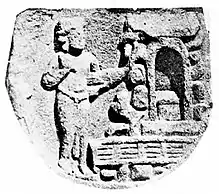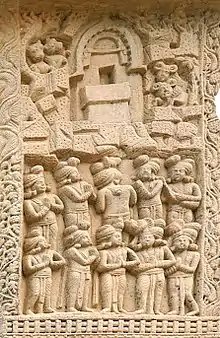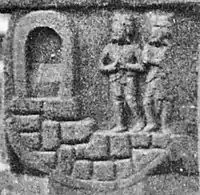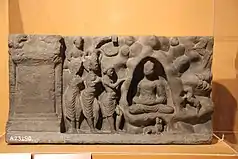Indrasala Cave
The Indasala Cave, also called Indrasila Guha or Indrasaila Cave, is a cave site mentioned in Buddhist texts. It is stated in Buddhist mythology to be the cave where Buddha lived for a while, and gave the sermon called the Sakkapañha Sutta to deity Indra. This Sutta is found as chapter II.21 of Digha Nikaya.[1] In this sermon, the Buddha addresses Sakya (also known as Indra) accompanied by Pancasikha (also known as Kubera).[2] After some harp-playing by Pancasikha, Indra asks 42 questions to the Buddha, which he answers. The teachings in this Indrasala Cave Sutta is, in part, the basis for the Theravada tradition of "punna (earning merit) and varam (favor).[1]


The legend is generally believed to be mythical. Some scholars, since the 19th century, have attempted to identify the location of the cave that may reflect one of the places the Buddha lived.[3] One such location is in modern Giryak, Bihar.[4] It has also been identified with a location on the Vediyaka hill near Rajagrha.[5]
Numerous depictions of the scene are known, the earliest being those of the Mahabodhi Temple at Bodh Gaya, circa 150 BCE. In a Gandhara artwork dated to 89 CE, the scene "Visit to the Indrasala Cave" is depicted with Indra identifiable with his elephant seated to the right, the Buddha is shown living in a cave by the wavy rocky landscape with wild animals above.[2]
 Visit of Indra to the Indrasala cave. The Buddha is symbolized by his throne in the cave (Mahabodhi Temple, Bodh Gaya, circa 150 BCE).
Visit of Indra to the Indrasala cave. The Buddha is symbolized by his throne in the cave (Mahabodhi Temple, Bodh Gaya, circa 150 BCE). The same scene in a 50-100 CE relief, Mathura art
The same scene in a 50-100 CE relief, Mathura art The same scene in a c. 2nd-century relief from Loriyan Tangai, Gandhara. The Buddha is shown in Indrasala cave.
The same scene in a c. 2nd-century relief from Loriyan Tangai, Gandhara. The Buddha is shown in Indrasala cave. Indra visiting the Buddha in the Indrasala cave, Preah Khan, style of the Bayon, Cambodia, 1190-1210 CE.
Indra visiting the Buddha in the Indrasala cave, Preah Khan, style of the Bayon, Cambodia, 1190-1210 CE.
See also
References
- John Ross Carter (1993). On Understanding Buddhists: Essays on the Theravada Tradition in Sri Lanka. State University of New York Press. p. 138. ISBN 978-0-7914-1413-2.; For one Theravada tradition translation of D II.21, Upalavanna Archived 2010-02-22 at the Wayback Machine
- Harle, James C. (1994). The Art and Architecture of the Indian Subcontinent. Yale University Press. pp. 78–79. ISBN 0300062176.
- Sir Alexander Cunningham; Great Britain. India Office (1879). The Stûpa of Bharhut: A Buddhist Monument Ornamented with Numerous Sculptures Illustrative of Buddhist Legend and History in Third Century B.C. W.H. Allen and Company. pp. 88–89.
- Prajñā-bhāratī. K.P. Jayaswal Research Institute. 1982. p. 61.
- The Indian Historical Quarterly. Ramanand Vidya Bhawan. 1956. p. 122.
